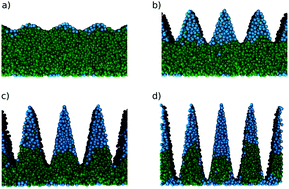Effect of controlled corrugation on capillary condensation of colloid–polymer mixtures
Abstract
We investigate with Monte Carlo computer simulations the capillary phase behaviour of model colloid–

* Corresponding authors
a
Theoretische Physik II, Physikalisches Institut, Universität Bayreuth, Universitätsstraße 30, D-95447 Bayreuth, Germany
E-mail:
andrea.fortini@uni-bayreuth.de
b Theoretische Physik II, Physikalisches Institut, Universität Bayreuth, Universitätsstraße 30, D-95447 Bayreuth, Germany
We investigate with Monte Carlo computer simulations the capillary phase behaviour of model colloid–

 Please wait while we load your content...
Something went wrong. Try again?
Please wait while we load your content...
Something went wrong. Try again?
A. Fortini and M. Schmidt, Soft Matter, 2013, 9, 3994 DOI: 10.1039/C3SM27659G
To request permission to reproduce material from this article, please go to the Copyright Clearance Center request page.
If you are an author contributing to an RSC publication, you do not need to request permission provided correct acknowledgement is given.
If you are the author of this article, you do not need to request permission to reproduce figures and diagrams provided correct acknowledgement is given. If you want to reproduce the whole article in a third-party publication (excluding your thesis/dissertation for which permission is not required) please go to the Copyright Clearance Center request page.
Read more about how to correctly acknowledge RSC content.
 Fetching data from CrossRef.
Fetching data from CrossRef.
This may take some time to load.
Loading related content
